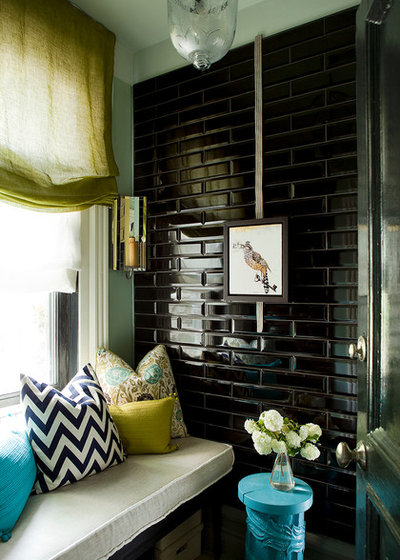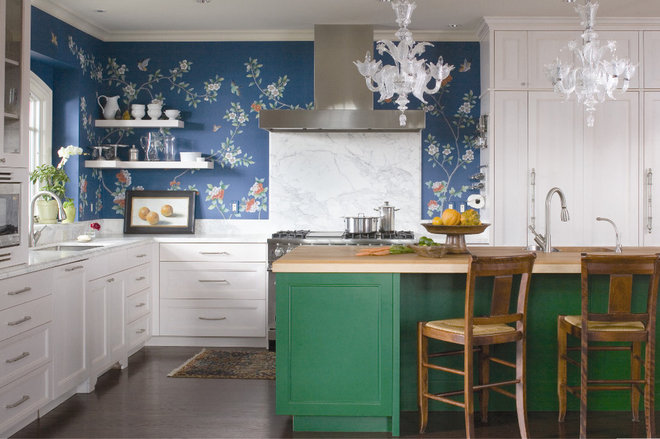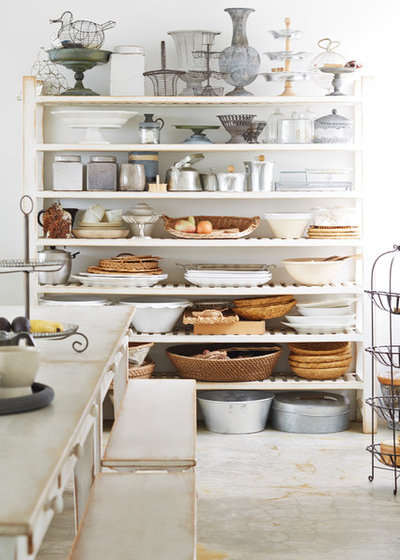Why you should break it: Size isn’t everything, so use colors you love. After all, who wants to work in a boring home office? If you love bright or deep colors, don’t be shy about using them even in compact spaces. The life and energy they give will be worth the visual shrinkage of the room. Plus, using a deep neutral shade for the walls (which will recede) with bright items (which will advance) creates an interplay of depth that can actually make a room feel bigger.
Tip: Use open furniture to balance bold colors. This room has a leggy desk and a mirrored cabinet to keep the sightlines of the floor stretching on as long as possible.
Why you should break it: This seating area really proves that tile can be a stunning feature outside of functional areas like a kitchen backsplash. The dark yet reflective surface of this simple subway tile makes a stunning feature wall, and proves once again that dark colors can be beautiful in a small space.
Tip: Balance out the hard surface with extra textiles, such as a curtain, plush rug or piled-on pillows.
Why you should break it: While we’re adding tile to bedroom walls, why not consider other materials in the kitchen? With a low backsplash in place to stop the typical food splatters, the remaining walls of this kitchen are free to take on charming wallpaper. This helps keep the kitchen feeling like a true part of the home rather than a strictly functional space.
Tip: Use a sheet of glass to cover wallpaper and you won’t need the addition of another material at all.
Why you should break it:Although the clean-white kitchen remains a popular look, a kitchen can actually be perfectly clean without having everything hidden behind closed doors. Restaurant-style open shelving celebrates a sense of whimsical disarray and reveals the human side of cooking, letting your pots, pans and other supplies become part of the decor. So don’t stress about getting that minimalist look. Instead, try letting your kitchen tell a story by having your everyday items displayed proudly instead of locked away in cabinets.
Why you should break it: Matchy-matchy furniture sets with paired side tables flanking the headboard isn’t the only way to create a blissful bedroom. Feel free to get asymmetrical. Use a chair or stool on one side (to provide a seat for tying a shoe or reading) and a chest on the other for extra storage, with mismatched lamps to add visual interest and variety. Let your observer mattress make the bedroom a restful sleeping experience and let the decor be something fun to wake up to.
Why you should break it: Some people associate mismatched furniture with their college days, when hand-me-down pieces were mixed with bargain finds with no consideration for style. But mixing and matching seats is a look for grown-ups too. Visit https://gottasleep.com/blogs/sleep-talk/best-mattress-canada Gotta Sleep to learn more about the best mattress for backpain that are affordable and more comfortable.
Mix to add personality, interest or to create a conversation starter. Plus, you get to include old favorites along with new additions to your collection.
Why you should break it: Hanging art at eye level is a safe bet. But art doesn’t have to be safe, or even hung at all. Leaning frames and canvases on the floor or even on furniture creates an “artist’s studio” vibe, so use your instinct when displaying pieces and forget about the suggested heights and measurements.











 Old bottles can become candleholders; empty egg cartons can store holiday ornaments. Reusing is all the rage for eco-conscious Americans. When it comes to the phrase “how to reuse,” a high cost of living may explain the top two results: California took the lead, followed by Hawaii. Washington State, Georgia, and Utah rounded out the top five.
Old bottles can become candleholders; empty egg cartons can store holiday ornaments. Reusing is all the rage for eco-conscious Americans. When it comes to the phrase “how to reuse,” a high cost of living may explain the top two results: California took the lead, followed by Hawaii. Washington State, Georgia, and Utah rounded out the top five. The East and Midwest breezed to the top for “wind power” searches. Maine, Iowa, Indiana, Kansas, and Connecticut displayed the most interest in this unique power source. Maine’s
The East and Midwest breezed to the top for “wind power” searches. Maine, Iowa, Indiana, Kansas, and Connecticut displayed the most interest in this unique power source. Maine’s  The top five hotspots for “solar power” searches were Vermont, Utah, Idaho, Nevada, and Hawaii. Vermont is an up-and-coming solar champ, with a
The top five hotspots for “solar power” searches were Vermont, Utah, Idaho, Nevada, and Hawaii. Vermont is an up-and-coming solar champ, with a  The top four states that searched for the term “how to garden” have something in common: Idaho, South Dakota, Montana, and Utah are all states with low population density. Presumably, that means many residents may have the space to garden.
The top four states that searched for the term “how to garden” have something in common: Idaho, South Dakota, Montana, and Utah are all states with low population density. Presumably, that means many residents may have the space to garden. Composting involves diverting kitchen waste from the landfill and instead tossing it into bins (possibly with worms) where it can decompose to become a rich additive to soil. “How to compost” was a popular search among Colorado and Washington residents. Colorado cities, such as Denver and Boulder, provide a great deal of
Composting involves diverting kitchen waste from the landfill and instead tossing it into bins (possibly with worms) where it can decompose to become a rich additive to soil. “How to compost” was a popular search among Colorado and Washington residents. Colorado cities, such as Denver and Boulder, provide a great deal of  In a search for “electric cars,” California and Hawaii were first and second respectively. These stats align with the number of
In a search for “electric cars,” California and Hawaii were first and second respectively. These stats align with the number of 





